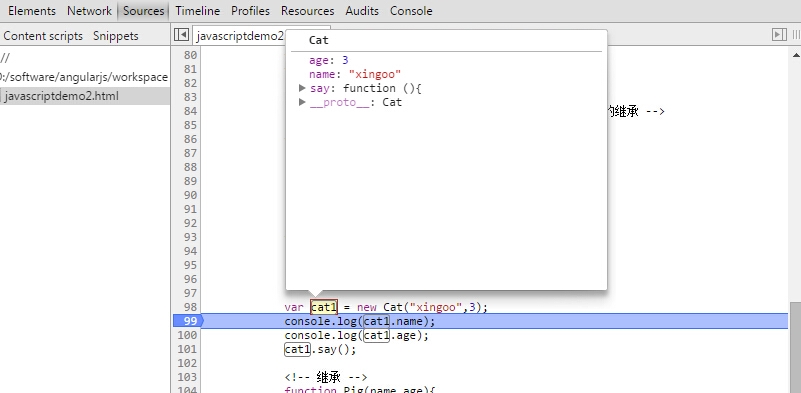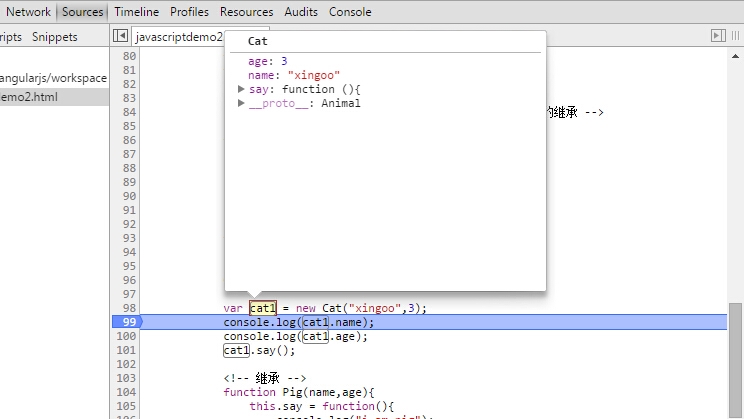JS面向对象高级特性
2017-03-22 09:29
471 查看
对象的创建方法:
对象的创建可以通过两种方式,第一种通过对象初始化的方法:var person={name:"xingoo",
age:26,
say:function(){console.log("say something");},
action:function(){console.log("do something");}
};
console.log(person.name);
console.log(person.age);
person.say();
person.action();
[/code]
第二种方式通过构造函数创建:
function student(name,age){this.name = name;
this.age = age;
this.say = function(){console.log("say something");}
this.action = function(){console.log("do something");}
}
var xingoo = new student("xingoo",27);console.log(xingoo.name);
console.log(xingoo.age);
xingoo.say();
xingoo.action();
[/code]
对象的属性
对象的属性分为对象属性、私有属性和类属性。对象属性需要创建对象后才能使用;
私有属性在内部可以直接使用,在外部需要通过闭包才能使用。
类属性可以通过对象名称直接使用。
function func(){this.objPro1 = "对象属性";
func.prototype.objPro2 = "对象属性";
var privatePro = "私有属性";
}
func.classPro = "类属性";
console.log(func.classPro);
var f = new func();
console.log(f.objPro1);
console.log(f.objPro2);
<!-- 私有属性可以通过闭包获取 -->
[/code]
对象的方法
对象方法包括:对象方法,私有方法和类方法,使用类似前面的属性。function demoFunc1(){var privateFunc = function(){console.log("this is privateFunc");};
privateFunc();
this.objFunc1 = function(){console.log("this is objFunc1");};
demoFunc1.prototype.objFunc2 = function(){console.log("this is objFunc2");};
}
demoFunc1.classFunc = function(){console.log("this is classFunc");};
demoFunc1.classFunc();
var f = new demoFunc1();
f.objFunc1();
f.objFunc2();
[/code]
继承、封装与多态
JS要想实现继承,需要通过apply方法或者prototype实现。如果单纯的使用apply方法,子类的原型是子类;如果使用prototype,那么子类的原型也将继承父类。
例如下面的代码:
function Animal(name,age){this.name = name;
this.age =age;
this.say = function(){console.log("animal say something");}
}
function Cat(name,age){Animal.apply(this,[name,age]);
}
<!-- Cat.prototype = new Animal();-->
var cat1 = new Cat("xingoo",3);console.log(cat1.name);
console.log(cat1.age);
cat1.say();
[/code]
上面代码中,cat的原型是cat;

如果开启注释的部分,可以发现,cat类的原型也变成了Animal。

子类的方法会覆盖父类的方法,即表现出多态性:
function Pig(name,age){this.say = function(){console.log("i am pig");}
}
Pig.prototype = new Animal();
function Dog(name,age){this.say = function(){console.log("i am dog");}
}
Dog.prototype = new Animal();
function say(animal){if(animal instanceof Animal){animal.say();
}
}
var dog = new Dog();
var pig = new Pig();
say(dog);
say(pig);
[/code]
使用到的全部代码:
<!doctype html>
<html>
<head>
<meta http-equiv="Content-Type" content="text/html; charset=utf-8" />
</head>
<body>
<script type="text/javascript">
<!-- 对象初始化器方式 -->
var person={name:"xingoo",
age:26,
say:function(){console.log("say something");},
action:function(){console.log("do something");}
};
console.log(person.name);
console.log(person.age);
person.say();
person.action();
<!-- 构造函数方式 -->
function student(name,age){this.name = name;
this.age = age;
this.say = function(){console.log("say something");}
this.action = function(){console.log("do something");}
}
var xingoo = new student("xingoo",27);console.log(xingoo.name);
console.log(xingoo.age);
xingoo.say();
xingoo.action();
<!-- 对象属性 私有属性,对象属性,类属性 -->
function func(){this.objPro1 = "对象属性";
func.prototype.objPro2 = "对象属性";
var privatePro = "私有属性";
}
func.classPro = "类属性";
console.log(func.classPro);
var f = new func();
console.log(f.objPro1);
console.log(f.objPro2);
<!-- 私有属性可以通过闭包获取 -->
<!-- 私有方法,对象方法,类方法 -->
function demoFunc1(){var privateFunc = function(){console.log("this is privateFunc");};
privateFunc();
this.objFunc1 = function(){console.log("this is objFunc1");};
demoFunc1.prototype.objFunc2 = function(){console.log("this is objFunc2");};
}
demoFunc1.classFunc = function(){console.log("this is classFunc");};
demoFunc1.classFunc();
var f = new demoFunc1();
f.objFunc1();
f.objFunc2();
<!-- 封装性,继承性,多态性 -->
<!-- apply()实现属性和方法的集成,prototype实现原型的继承 -->
function Animal(name,age){this.name = name;
this.age =age;
this.say = function(){console.log("animal say something");}
}
function Cat(name,age){Animal.apply(this,[name,age]);
}
<!-- Cat.prototype = new Animal();-->
var cat1 = new Cat("xingoo",3);console.log(cat1.name);
console.log(cat1.age);
cat1.say();
<!-- 继承 -->
function Pig(name,age){this.say = function(){console.log("i am pig");}
}
Pig.prototype = new Animal();
function Dog(name,age){this.say = function(){console.log("i am dog");}
}
Dog.prototype = new Animal();
function say(animal){if(animal instanceof Animal){animal.say();
}
}
var dog = new Dog();
var pig = new Pig();
say(dog);
say(pig);
</script>
</body>
</html>
[/code]
运行结果:

相关文章推荐
- JS面向对象高级特性
- JS面向对象高级特性
- 10面向对象高级特性三
- 深入PHP面向对象、模式与实践——高级特性(1)
- 深入PHP面向对象、模式与实践——高级特性(3)
- JS——面向对象高级
- Java第四次作业--面向对象高级特性(继承和多态)
- PHP面向对象高级特性
- 面向对象高级特性--类的继承、接口(概念类)
- 【javascript】javascript之面向对象高级特性
- 09面向对象高级特性二
- 深入PHP面向对象、模式与实践——高级特性(2)
- 深入PHP面向对象、模式与实践——高级特性(5)
- 面向对象语言概论(三) 基于类的高级特性
- JS高级 - 面向对象1(this,Object ,工厂方式,new )
- 面向对象高级特性===Java抽象类的概念和使用
- 08面向对象高级特性一
- JAVA面向对象高级特性之继承(1)常见问题解答
- JS面向对象特性和值类型与复合类型
- 面向对象高级特性--Java中的包、类的封装和内部类(概念类)
